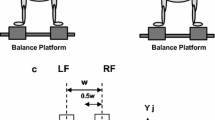Summary
X-ray photography was employed to analyse the postural syndromes following unilateral global and selective lesions of the vestibular apparatus in guinea pigs. Following hemilabyrinthectomy, head rotation in the horizontal plane resulted mainly from rotation of the cervical vertebrae whereas lateral head tilt was due to the rotation of thoracic vertebrae about the longitudinal axis. These results support our previous conclusion that because of both resting posture and intrinsic biomechanical constraints, the number of degrees of freedom of the cervical column is reduced and the cervical vertebrae are functionally specialized. Selective lesions of the vestibular apparatus have aided in determining the origin of the different components of the hemilabyrinthectomy syndrome: rotation of thoracic vertebrae was caused by unilateral lesion of the otolithic system whereas rotation of the head in the horizontal plane resulted from unilateral lesion of the horizontal semicircular canal system. We conclude that the functional segmentation of the cervical column corresponds to a differential distribution of vestibular afferents.
Similar content being viewed by others
References
Akaike T, Fanardjian VV, Ito M, Ohno T (1973) Electrophysiological analysis of the vestibulospinal reflex pathway of rabbit. II. The synaptic action upon spinal neurons. Exp Brain Res 17:497–515
D'Ascanio P, Gahery Y, Pompeiano O, Stampachia G (1986) Effects of pressure stimulation of the body surface on posture and vestibulospinal reflexes. Arch Ital Biol 124:43–63
Azzena GB (1969) Role of the spinal cord in compensating the effects of hemilabyrinthectomy. Arch Ital Biol 65:43–53
Berthoz A, Anderson JH (1971a) Frequency analysis of vestibular influence on extensor motoneurons. I. Response to tilt in forelimb extensors. Brain Res 34:370–375
Berthoz A, Anderson JH (1971b) Frequency analysis of vestibular influence on extensor motoneurons. II. Relationship between neck and forelimb extensors. Brain Res 34:376–380
Chan YS, Hwang JC, Cheung YM (1977) Crossed sacculoocular pathway via the Deiters nucleus in cats. Brain Res Bull 2:1–6
Curthoys IS, Harris R, Smith PF (1987) Effect of unilateral labyrinthectomy on neural activity in the guinea pig vestibular nuclei. In: The vestibular system: neurophysiology and clinical research. Raven Press, New York, pp 677–687
Graf W, Simpson JI (1981) The relations between the semicircular canals, the optic axis, and the extraocular muscles in lateral-eyed and frontal eyed animals. In: Fuchs A, Becker W (eds) Progress in oculomotor research: developments in neuroscience, Vol 12. Elsevier, North Holland Biomed Press, New York Amsterdam Oxford, pp 409–417
Graf W, Vidal PP, Evinger LC (1986) How animals moves their heads. Proc Int Union Physiol Sci 16:394–411
Graf W, Ezure K (1986) Morphology of the vertical canal related second order vestibular neurons in the cat. Exp Brain Res 63:35–48
Jensen DW (1979) Reflex control of acute postural asymmetry and compensatory symmetry after a unilateral vestibular lesion. Neuroscience 4:1059–1073
Manzoni D, Pompeiano O, Srivastava UC, Stampachia G (1983) Response of forelimb extensors to sinusoidal stimulation of macular labyrinth and neck receptors. Arch Ital Biol 121:205–214
Magnus R (1924) Körperstellung, 735, Springer, Berlin
Precht W (1986) Recovery of some vestibuloocular and vestibulospinal functions following unilateral labyrinthectomy. In: Freund HJ, Büttner U, Cohen B, Noth J (eds) Progress in brain research, vol 64. Elsevier Science Publishers BV, Amsterdam, pp 381–389
Ried S, Maioli C, Precht W (1984) Vestibular nuclear neuron activity in chronically hemilabyrinthectomized cats. Acta Oto-Laryng (Stockholm) 98:1–13
Roberts TDM (1973) Reflex balance. Nature 244:156–158
Schaefer KP, Meyer DL (1974) Compensation of vestibular lesions. In: Kornhuber HH (ed) Handbook or sensory physology, Vol VI, Part 2. Springer, New York, pp 463–490
Schor RH, Miller AD (1981) Vestibular reflexes in neck and forelimb muscles evoked by roll tilt. J Neurophysiol 46:167–178
Simpson JI, Graf W (1981) Eye muscle geometry and compensatory eye movement in lateral-eyed and frontal-eyed animals. Ann NY Acad Sci 374:20–30
Smith PF, Darlington CL, Curthoys IS (1986a) Vestibular comensation without brainstem commissures in the guinea pig. Neurosci Lett 65:209–212
Smith PF, Darlington CL, Curthoys IS (1986b) The effect of visual deprivation on vestibular compensation in the guinea pig. Brain Res 364:195–198
Suzuki JI, Cohen B, Bender MB (1964) Compensatory eye movements induced by vertical semi circular canal stimulation. Exp Neurol 9:137–160
Tokizane T, Murao M, Ogata T, Gondo T (1951) Electromyographic studies on tonic neck, lumbar and labyrinthine reflexes in normal persons. Jpn J Physiol 2:130–146
Vidal PP, Graf W, Berthoz A (1986) The orientation of the cervical column in unrestrained awake animals. I. Resting position. Exp Brain Res 61:549–559
Vidal PP, de Waele C, Graf W, Berthoz A (1988) Skeletal geomtry underlying head movements. Ann NY Acad Sci (in press)
de Waele C, Graf W, Vidal PP (1987) Biomechanical constraints limit the number of degrees of freedom of the vertebrate head neck ensemble: its consequences for the postural syndrome following hemilabyrinthectomy. Soc Neurosci Abstr 13:3387
Wilson VJ, Yoshida M, Schor RH (1970) Supraspinal monosynaptic excitation and inhibition of thoracic back motoneurons. Exp Brain Res 11:282–295
Wilson VJ, Maeda M (1974) Connections between semi-circular canals and neck motoneurons in the cat. J Neurophysiol 37:346–357
Wilson VJ (1977) Saccular and utricular input to cat neck motoneurons. J Neurophysiol 40:63–73
Wilson VJ, Schor H, Susuki I, Park BR (1986) Spatial organization of neck and vestibular reflexes acting on the forelimbs of the decerebrate cat. J Neurophysiol 55:514–526
Wilson VJ (1988) The tonic neck reflex: spinal circuitry. In: Peterson BW, Richmond FJ (eds) Control of head movement. University Press, New York Oxford, pp 100–108
Xerri C, Gianni S, Manzoni D, Pompeiano O (1983) Central compensation of vestibular deficits. I. Response characteristics of lateral vestibular neurons to roll tilt after ipsilateral labyrinth deafferentation. J Neurophysiol 50:428–448
Author information
Authors and Affiliations
Rights and permissions
About this article
Cite this article
De Waele, C., Graf, W., Josset, P. et al. A radiological analysis of the postural syndromes following hemilabyrinthectomy and selective canal and otolith lesions in the guinea pig. Exp Brain Res 77, 166–182 (1989). https://doi.org/10.1007/BF00250579
Received:
Accepted:
Issue Date:
DOI: https://doi.org/10.1007/BF00250579




